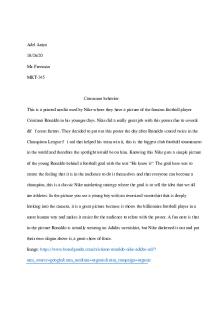Consumer behavior by Schiffman, Leon G. Wisenblit, Joseph (pdf PDF

| Title | Consumer behavior by Schiffman, Leon G. Wisenblit, Joseph (pdf |
|---|---|
| Author | Asif Kureishi |
| Course | Marketing Research |
| Institution | Abbottabad University of Science and Technology |
| Pages | 35 |
| File Size | 1.1 MB |
| File Type | |
| Total Downloads | 89 |
| Total Views | 131 |
Summary
abc...
Description
Other Family Members
Friends
Influence More Basic Values/Behavior
Influence More Expressive Attitudes/Behavior
• Moral/religious principles • Interpersonal skills • Dress/grooming standards • Manners and speech • Educational motivation • Occupational/career goals • Consumer behavior norms
Preadolescent
• • • • •
Adolescent
Style Fashion Fads “In/Out” Acceptable consumer behavior
Teenager Older
PERMISSIVE Indulgent
Neglecting
Highly aware of advertising Talk to children about advertising Yield to children’s requests Favor regulating advertising Grant children consumption autonomy Discuss consumption and value with children
Some talk to children about advertising Yield to children’s requests, often too easily Favor regulating advertising Grant children consumption autonomy
VERY NURTURING
NOT NURTURING Restrict advertising exposure Suspicious of advertising Favor regulating advertising Often watch TV with their children Talk with children about consumption Rely on consumer guidebooks
Children must conform and obey rules Restrict environmental influences Highly negative attitudes towards advertising Unlikely to yield to children’s request easily
Authoritative
Authoritarian RESTRICTIVE
Stage1: Shopping with Parents and Observing • Age 12–15 months • Children notice products that are fun to eat and play with and begin to recall specific ones. • Parents may buy some items to reward children for good behavior.
• Age 2–3 years • Children begin to connect advertising with items in the stores and delight parents with cognitive development. • They request items by pointing.
Stage 3: Shopping with Parents and Making Some Selections • Age 3–7 years • Children begin to distinguish ads from programs, associate brand names with product categories, and understand the basic script of consumption. Children can evaluate products and make decisions about spending, saving, and giving to charity. Children pester their parents to buy products, but also begin to acquire and use negotiation skills. • At age 6–7 some children receive their first smartphone and begin using it for texting, apps, games, and calls.
Stage 4: Shopping Independently • Age 7–11 years • Parents gradually and often reluctantly begin to allow children to go to stores or shop online alone or with friends. Children discover the wonders of shopping and deciding among choices. Children understand the persuasive intent of ads, begin to process functional cues regarding products, and develop purchase influence and negotiation strategies. • 45% of mobile kids get a smartphone between the age of 10–12 and use it predominantly for texting. It is expected that by the year 2020 almost 50% of all smartphone users will be 11 years old or younger.
Stage 5: Complex Shopping and Skepticism • Age 11–16 years • Pre-teens and teenagers understand advertising tactics and appeals, become skeptical about ads, and understand complex shopping scripts. They are adept at negotiation and are able to influence purchase decisions. • It is expected that by 2020 almost 93% of all smartphone users will be between the age of 12–17.
Food at Home Food Away from Home Alcoholic Beverages Housing Apparel and Services Transportation Healthcare Entertainment Personal Care Products and Services Reading Education Tobacco Products and Smoking Supplies Miscellaneous Cash Contributions Personal Insurance and Pensions $0
$2,000
$4,000
$6,000
$8,000 $10,000 $12,000 $14,000 $16,000 $18,000 $20,000
Bachelorhood
Honeymooners
Parenthood
Parenthood
Dissolution
Delayed Marriage (e.g,. marrying after age 30 often to start careers first)
Single Parents (e.g., never married, divorced, widowed)
Families with one child
Large Families (e.g., ranging from 5 to as many as 19 children)
Extended Families (e.g., parents, children, grandparents, aunts, uncles, and additional relatives in the same household)
Blended Families and Joint Families (e.g., parents bringing children together into new families)
Grandparent Families (e.g., grandparents raising their grandchildren with the parents not in the home)?
Boomerang Families (e.g., grown children returning to live with their parents)
Childless Families (e.g., married and unmarried, no children by choice and not by choice)
Adult children caring for their elderly parents
Multicultural Families (e.g., mixed race couples with children and/or parents adopting children from different cultures)
Adoptive Families (e.g., parents adopting children)
Caregivers as Part of the Family (e.g., caregivers for elderly parents, and caregivers for children)
Polygamous and Polyandrous Families (e.g., one husband and many wives, one wife and many husbands); many children is common in this family structure
2–3 children, married and not married)
Same-Gender Families (e.g., with children, without children, married, and not married)
75 and Over 65–74 Family Households 50–64
One-Person Households
35–49
Persons Living With Nonrelatives
25–34 15–24 0
10
20
30
40
Female 70 and Over Male 70 and Over Female 60–69 Male 60–69 Female 50–59
Two Persons
Male 50–59
Three Persons
Female 35–49
Four or More Persons
Male 35–49 Female 25–34 Male 25–34 Female 15–24 Male 15–24 2
0
4
6
Age and Matrimonial Position
65 and Over
55 to 64 Female-Female Couples Male-Male Couples 45 to 54
Total Same-Gender Couple s Unmarried Opposite Gender Married Opposite Gender
35–44
25 to 34
Under 24
0
5
10
15
20
25
30
35
40
Income and Matrimonial Position
Female–Female Couples
$ 100,000 or More
Male–Male Couples
$ 75,000 70 $ 99,999 $ 50,000 to $ 74,999 Total Same-Gender Couples
$ 35,000 to $ 49,999 Less than $ 35,000
Unmarried Opposite Gender
Married Opposite Gender
0
10
20
30
40
50
60
Scientist Firefighter Military Officer Engineer Nurse Architect Emergency Medical Technician (EMT) Veterinarian Police Officer
Pharmacists Medical Doctors/ Engineers Police Officer Dentists College Teachers Clergy Psychiatrists/Chiropractors
of Congress Senators Car Salespeople Journalists Advertising Practitioners Stockbrokers Insurance Salespeople Lawyers State Governors Business Executives
Lower-Upper (Nouveau Riche) Upper-Middle Lower-Middle Upper-Lower (Working Class) Lower (Working Poor) Lower-Lower (Underclass)
$ 100,000 or Higher $ 60,000–99,000 $ 30,000–59,000 Up to $ 29,000
Live with Roommates Live Independently
High School or Less
Live in Parents’ Home
Associate Degree Bachelor or Higher
Not in Labor Force Unemployed Employed Full-Time
Men Women 0.00%
10.00%
20.00%
30.00%
40.00%
50.00%
60.00%
70.00%
80.00%
90.00% 100.00%
$ 100,000 or Higher $ 60,000–99,000 $ 30,000–59,000 Up to $ 29,000
Live with Roommates Live Independently
High School or Less Associate Degree Bachelor or Higher
Not in Labor Force Unemployed Employed
Men Women
Live in Parents’ Home...
Similar Free PDFs

Consumer behavior
- 5 Pages

Consumer Behavior
- 33 Pages

Lecture 6 Consumer Behavior
- 2 Pages

Consumer Behavior Final Exam
- 2 Pages
![[PDF] Cost Accounting by De Leon 1](https://pdfedu.com/img/crop/172x258/m52yodwnjm3e.jpg)
[PDF] Cost Accounting by De Leon 1
- 86 Pages

MCQs-Consumer-Behavior
- 24 Pages

Consumer Behavior quiz
- 1 Pages

Case Study Consumer Behavior
- 3 Pages

Jada May - consumer behavior
- 5 Pages

Consumer behavior séance 2
- 5 Pages

2 Symbolic Consumer Behavior
- 11 Pages

Readings Summary - Consumer Behavior
- 62 Pages

Final Report Consumer Behavior
- 19 Pages
Popular Institutions
- Tinajero National High School - Annex
- Politeknik Caltex Riau
- Yokohama City University
- SGT University
- University of Al-Qadisiyah
- Divine Word College of Vigan
- Techniek College Rotterdam
- Universidade de Santiago
- Universiti Teknologi MARA Cawangan Johor Kampus Pasir Gudang
- Poltekkes Kemenkes Yogyakarta
- Baguio City National High School
- Colegio san marcos
- preparatoria uno
- Centro de Bachillerato Tecnológico Industrial y de Servicios No. 107
- Dalian Maritime University
- Quang Trung Secondary School
- Colegio Tecnológico en Informática
- Corporación Regional de Educación Superior
- Grupo CEDVA
- Dar Al Uloom University
- Centro de Estudios Preuniversitarios de la Universidad Nacional de Ingeniería
- 上智大学
- Aakash International School, Nuna Majara
- San Felipe Neri Catholic School
- Kang Chiao International School - New Taipei City
- Misamis Occidental National High School
- Institución Educativa Escuela Normal Juan Ladrilleros
- Kolehiyo ng Pantukan
- Batanes State College
- Instituto Continental
- Sekolah Menengah Kejuruan Kesehatan Kaltara (Tarakan)
- Colegio de La Inmaculada Concepcion - Cebu


